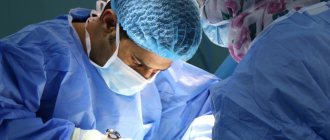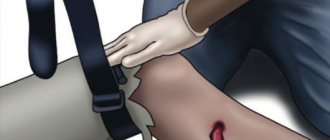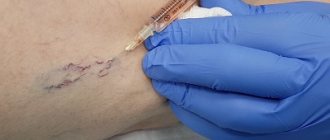The veins of the lower extremities ensure uninterrupted outflow of blood, participate in the regulation of blood pressure, and transport hormones, enzymes, amino acids and other organic substances. The vascular system of the legs is the most vulnerable because it is far from the heart, but at the same time experiences constant physical stress. Impaired blood flow and depletion of blood vessels leads to their stretching and rupture.
Telangiectasia - dilation and rupture of small vessels (capillaries, venules and arterioles) is most often expressed only in external cosmetic defects. If a vein in the leg bursts, it is accompanied by pain and hemorrhage. In severe cases, perforation of the vascular wall is accompanied by severe bleeding, requiring emergency medical attention.
Differences between vessels
Venous and arterial vessels should not be confused. In the body, these elastic tubes perform various functions and differ in structure, location and number. It’s a vein that can burst in your leg, not an artery, and here’s why:
- The artery has thick walls with many smooth muscle fibers and can withstand the powerful pressure of the blood flow. Venous walls are several times thinner.
- The veins along their entire length are equipped with valves that prevent reverse blood flow. Arterial valves are present only at the exit of blood vessels from the heart.
- The arteries are located deep under the skin, protruding only in a few areas of the body where the pulse can be felt (neck, temples, wrist). The venous network is located superficially.
- Arterial vessels carry oxygenated blood from the heart to the organs. Venous blood, filled with carbon dioxide, moves in the opposite direction.
When an artery ruptures, blood is ejected in a fountain - this condition is life-threatening. Venous bleeding is characterized by the uniform flow of a smaller volume of blood into the subcutaneous tissue (internal) or outside the body (external).
Why could a blood vessel in my leg burst?
There are many factors contributing to this. Let's look at the main ones:
- heavy load;
- genetic predisposition;
- long walking;
- injuries;
- lack of vitamins;
- frostbite;
- excess body mass index.
With improper blood flow, the venous valves fail to cope, redistributing blood into the superficial veins, where it stagnates, the walls of the vessels stretch and eventually burst. A hematoma appears instantly; it can transform into gangrene and cause sepsis.
Briefly about the structure of venous walls
The venous system of the lower extremities consists of superficial and deep vessels connected by a network of perforating ducts. The walls of the veins consist of three layers, each of which is endowed with certain functional responsibilities:
- Endothelium (intima) or inner layer. Protects against the effects of substances carried through the bloodstream.
- Media or middle layer. Consists mainly of elastic fibers responsible for tension/relaxation of the wall and vascular tone.
- Adventitia or outer layer. Contains collagen fibers that connect the vessel with muscle tissue and microscopic vessels that supply oxygen to the wall itself. Responsible for protection against perforation.
When the walls are dysfunctional, due to their exhaustion or extreme tension, the veins rupture.
Reference! Angiopathy of the lower extremities is a systemic lesion of blood vessels of all sizes. The pathology is corrected by an angiosurgeon. Varicose veins of the legs - expansion and increase in the lumen of the veins with the formation of nodes. Conservative or surgical treatment is carried out by a phlebologist.
What are the dangers of injuries to large vessels?
When a large artery and vein are simultaneously damaged, a serious complication such as an arteriovenous fistula
. This, in turn, causes the appearance of a false arteriovenous aneurysm. Its main danger is that it often becomes inflamed with the formation of pus. The consequences of opening such phlegmons are very serious. Sometimes vascular injuries are diagnosed only after the appearance of such aneurysms.
Arteriovenous fistulas are found quite often, but the most dangerous of them is a fistula in the neck area. It can cause heart failure. If the fistula is not recognized in time, gangrene may develop.
Causes of vein rupture
The key reason why leg veins burst is varicose veins. Deformation of the vascular walls occurs due to the destruction of the valves. Blood begins to move not only up (towards the heart), but also down. This creates excess pressure on the walls.
The veins no longer cope with the load, expand, lengthen, bend, taking on tortuous shapes. Trophism (the process of cellular nutrition) and innervation (supply of nerves) of the lower extremities are disrupted. There are three stages of the disease:
- compensated - telangiectasia, single dilated vessels on one or both legs, without obvious symptoms;
- subcompensated – pronounced external changes in the veins, the appearance of nodes, swelling of the limbs, pain, cramps at night, eczema;
- decompensated - symptoms of subcompensation intensify, nodes progress, pre-ulcers and trophic ulcers form.
The risk of vein destruction exists from the first stage and only increases in the future. In the presence of varicose veins, triggers for vascular destruction are:
- nicotine addiction;
- alcohol abuse;
- excess weight;
- hormonal changes, including pregnancy;
- sedentary lifestyle (physical inactivity) or excessive physical activity;
- deficiency of the vitamin and mineral component of the diet;
- tissue damage caused by high or low temperatures (burns or frostbite);
- chronic diseases of the cardiovascular and endocrine systems.
An age-related decrease in the elasticity of blood vessels is associated with general wear and tear (aging) of the body. The development of internal venous bleeding can be triggered by taking medications that affect coagulation processes (blood clotting) or impaired peripheral circulation.
In the ankle area, perforation can occur due to constant wearing of narrow, compressive shoes. Open (external) venous bleeding occurs due to mechanical damage to the legs (deep wounds, animal bites, open fractures, etc.), with a violation of the integrity of the skin.
Signs of perforation
The main and clearly visible sign of a burst vein in the leg with hemorrhage into the subcutaneous layer is the appearance of a hematoma (accumulation of liquid, thickened or coagulated blood in the subcutaneous fat). The size and color of the resulting bruise can indicate the extent of the internal damage.
The accumulation of blood at the site of the vein rupture forms edema. A swelling of the tissues forms, which feels painful when pressed. With cracks in the veins or perforation of venules and capillaries, there are no significant somatic symptoms. More significant damage is accompanied by:
- pain in the limb (at the moment of the rupture - acute);
- paresthesia (sensitivity disorder in the legs, burning sensation, crawling “goosebumps” in the damaged area);
- paleness of the skin and mucous membranes;
- loss of strength (weakness) and dizziness;
- lack of air;
- polymorphic opacities in the field of vision (“flying spots before the eyes”);
- discomfort in the epigastric region (nausea).
Excessive internal bleeding can cause short-term fainting (syncope). External venous bleeding with damage to the skin is characterized by a slow flow of blood that has a specific dark cherry color, pain, severe nausea (vomiting may occur), and severe pallor of the skin. A person feels cold in the affected limb and chills throughout the body. Loss of consciousness is possible from painful shock (in especially impressionable people and from the sight of blood).
Clinical picture and diagnosis of blood vessel damage
Of course, one of the first symptoms of traumatic damage to blood vessels is the occurrence of characteristic bleeding
, however, it can only be seen with open wounds. Any intense bleeding should alert a specialist.
A simple palpation of the pulse slightly to the side of the wounded area can help make a correct diagnosis. However, the method is not 100% reliable. If a large arterial trunk is injured, a more accurate symptom will be the appearance of a swelling that quickly grows and pulsates. You can literally try to listen to such a wound, because such injuries produce a very noticeable blowing noise, sometimes compared to the purring of a cat.
In addition, you should pay attention to the skin at some distance from the wound: their pallor may also indicate damage to large vessels.
The most unambiguous sign that indicates major damage to the arteries and veins is gangrene of the limb
.
An accurate diagnosis is made after a vasographic X-ray contrast study. Capillaroscopy and thermography may be informative. Blood tests help in diagnosis, as well as a non-invasive research method such as Doppler sonography.
Treatment of internal venous hemorrhage
Primary treatment for mild to moderate tears is to cool the area of the leg. Under the influence of cold, the blood vessels narrow and the bleeding stops. Pharmacies sell special hypothermic packages for providing first aid for bruises and internal hemorrhages.
Hypothermic first aid package “Snowball”. Package composition: - ammonium nitrate, g 30+-3 - water, g 25+-5
At home, ice wrapped in cotton cloth or any frozen product from the freezer wrapped in cloth will be suitable for first aid. After applying the compress, the limb must be placed on a pillow or cushion to ensure blood flow in the desired direction.
In the future, a bruise caused by a burst vein is treated with drugs for external use that have anti-inflammatory, blood-thinning, anti-edematous, and angioprotective effects. Examples of gels and ointments:
- Traumeel;
- Bruise OFF;
- Troxevasin;
- Badyaga 911;
- Lyoton;
- Express Bruise;
- Heparin ointment;
- Viprosal.
In case of a large-scale hematoma, it is necessary to apply a compressive bandage below the damaged area, carry out identical manipulations to cool the damaged area and seek medical help. For extensive internal bleeding and complicated hematomas, the following is practiced:
- puncture (pumping out) of biological fluid using a needle with a large lumen;
- surgical opening with a scalpel, followed by the application of self-absorbing sutures to the damaged vein.
The autopsy procedure is carried out under the influence of local anesthetics.
First aid for open injury
What to do if the vein and tissue are damaged, and blood continuously flows out? First of all, you should call an ambulance. Extensive venous bleeding without timely medical intervention threatens the loss of a large volume of blood and blockage of the blood vessel by air bubbles (air embolism).
Before the brigade arrives, the victim needs to receive emergency assistance. First of all, you should identify the damaged area and try to stop the bleeding. To do this, use a tourniquet (if not available, replace it with a belt, belt, etc.) and dressing material (medical special bags, gauze and bandage, any clean cloth).
Algorithm of actions:
- Lift the limb with the burst vein up and, placing available means under it, fix it in this position.
- Using a dressing material, tightly (important!) bandage the wound. Below the damaged area, tighten the bandage tightly to block the natural circulation of venous blood from bottom to top.
- A compressive tourniquet (belt) is applied a few centimeters below the bleeding area over clothing. If the limb is exposed, any fabric must be placed under the tourniquet. Be sure to record the time of the procedure on paper. You can clamp a limb for no more than one and a half hours. Otherwise, tissue necrosis may begin. Place paper with the time recorded under the tourniquet.
The use of a tourniquet is mandatory for arterial bleeding. If a vein is damaged, it is advisable to use a tourniquet when the bleeding does not stop after applying a bandage.
Vascular surgery of the lower extremities
After providing first aid for a burst vein, the next step should be surgery. The purpose of the intervention is to remove the damaged part of the vessel. Depending on the scale of the perforation and the general condition of the vessels, various methods of vascular surgery can be used:
- elos-coagulation – laser treatment of varicose veins using elos technology;
- sclerotherapy and its varieties (compression sclerotherapy, echosclerotherapy, microfoam sclerotherapy) - the introduction of a special drug into the vessels, leading to scarring of the vascular walls;
- miniphlebectomy is a minimally invasive technique for removing part of a vessel through a small puncture;
- Phlebectomy – surgical excision of a section of a damaged vein.
- laser coagulation – sealing of blood vessels with a laser beam.
The newest method used in phlebology is radiofrequency ablation - the adhesion of venous walls under the influence of radio wave radiation.
Ultrasound duplex scanning
Ultrasound duplex scanning allows you to determine the patency of the arteries, localize the site of blockage of the vessel and the state of blood flow below the site of occlusion. Often, in acute ischemia, this diagnosis is enough to determine treatment tactics and send the patient to the operating table. With an embolism or rupture, the arteries below the blockage are usually empty or thrombosed, and blood flow in them is not detectable. Blood flow in the veins is sharply slowed down. With thrombosis, blood flow can be detected below the site of blockage, but its speed is sharply reduced; most often, blood flow through the main vessels cannot be detected, but blood flow can be seen through collaterals. As a rule, this is due to
Drug treatment
After vein perforation, the patient is prescribed a number of medications necessary to restore and maintain normal blood flow, eliminate formed blood clots, increase the tone of the vascular walls, prevent and eliminate the inflammatory process:
- venotonics for oral and external use - Venarus, Troxevasin, Detralex, etc.;
- anticoagulants – Thrombo Ass, Curantil, Fraxiparine;
- vitamins – vitamin complexes with a high content of ascorbic acid;
- thrombolytics (fibrinolytics) – Actylase, Retaplase, etc.;
- non-steroidal anti-inflammatory drugs (NSAIDs) - Ibuprofen, Diclofenac, Ketanov.
The doctor determines the dosage regimen and dosage individually.
Prevention
Varicose veins of the lower extremities must be treated from the first manifestations. To prevent the disease from passing into the decompensated stage, rupture of veins, and the occurrence of intermittent claudication, it is necessary to use preventive measures:
- wearing compression garments (stockings, tights, knee socks);
- refusal of nicotine and alcohol;
- regular classes of special therapeutic exercises for varicose veins;
- eating foods rich in vitamin C;
- daily contrast dousing of legs.
If you have problems with your veins, you should be regularly examined by a phlebologist.
How to prevent varicose veins
Results
Perforation of a vein in the leg is most often a consequence of varicose veins. The walls of blood vessels lose their elasticity, and the venous valves responsible for reverse blood flow are destroyed. This leads to stretching and rupture of the veins. When a vein bursts, blood flows into the subcutaneous layer, forming a hematoma. Its size depends on the extent of damage to the vessel.
Minor bruises can be treated at home using a cold compress and ointments. Open venous bleeding occurs when a vessel ruptures and the integrity of the skin tissue is simultaneously damaged. The person needs to provide first aid, call an ambulance, or take the victim to the hospital themselves.
Prevention of bleeding from varicose veins
Modern prevention of bleeding from varicose veins consists of adequate and timely treatment of varicose veins. The leading specialist of the Moscow city phlebological center, Artyom Yuryevich Semyonov, helped hundreds of patients with developed bleeding from varicose veins, and helped thousands of patients avoid it. Modern medical technologies that are used in the city phlebology center can not only cure bleeding from varicose veins, but also prevent it. We use European innovations as efficiently as possible to preserve and maintain your health. The doors of our leading medical center in Moscow are open not only to residents of Moscow and the Moscow region, but also to any other region of our state.










